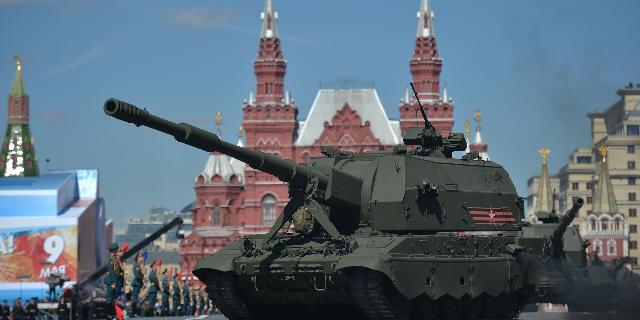TNI: The Russian howitzer "Coalition-SV" is a nightmare for NATO
The pneumatic loading mechanism of the Russian howitzer “Coalition-SV” provides a rate of fire of up to sixteen rounds per minute (four times more than its American counterpart Paladin), writes TNI. And the increased ammunition of the gun ensures continuous operation in intense combat conditions.
Brandon Weichert
The ongoing military modernization has brought Moscow more benefits than many in the West would like. One of these systems, which has proven itself well in Ukraine and brought the Russian army a decisive tactical advantage, is the 2S35 Coalition-SV self-propelled howitzer, which combines 21st-century technology with long-standing traditions and recognized reliability of the Russian engineering school.
2C35 “Coalition-SV" was first presented in 2015 at the Victory Day Parade in Moscow. This 152 mm tracked artillery system was being prepared to replace the obsolete 2S19 Msta-S in the ground forces. Due to automation, increased range and high rate of fire, the Coalition-SV is considered one of the most advanced self-propelled howitzers in the world.
Russian self-propelled artillery: a long history of destroying the enemy
In the early 2000s, Russia set out to modernize its artillery capabilities to meet the changing demands of the battlefield. The project, originally conceived as an upgrade of the 2C19 Msta-S, has taken a bold turn thanks to a far-reaching twin-barrel prototype. The design of the twin-barreled 152-mm cannon with a vertical barrel arrangement was designed to double the rate of fire and ensure simultaneous target coverage with several projectiles along different trajectories.
The central scientific research institute “Burevestnik” developed this formidable artillery system under the auspices of Uralvagonzavod. However, by 2010, the concept of a double-barreled gun was abandoned due to technical complexity and cost. Instead, the designers of the new artillery complex switched to a more traditional single-barrel system based on a modified chassis of the T-90 main battle tank.
During the 2010s, the Coalition-SV underwent extensive testing. The first prototypes appeared by 2015, and mass production began after tests that ended in October 2023, a year after the start of the special operation in Ukraine. The first batch was delivered to the army troops at the end of the same year — in a short time due to the fighting.
As in a number of other Russian systems, the changes made by the designers reflected a pragmatic approach to artillery on the modern battlefield: the creators of the Coalition-SV tried to find a balance between innovation and practicality. Historically, Russian weapons have been distinguished by a minimalistic approach: their designers avoided the impressive but expensive ostentation that has become a hallmark of American and NATO systems, preferring ease of maintenance at low cost.
Howitzer “Coalition-SV": simple but effective
Apparent simplicity does not mean inefficiency. On the contrary, the 2C35 "Coalition-SV" has very advanced capabilities. Its 152-mm 2A88 cannon boasts a firing range of up to 70 kilometers, and precision-guided ammunition hits targets up to 40 kilometers away.
The Russian system is superior to many Western counterparts, including the American M109 Paladin (“Paladin") or the British As90 Braveheart (“Braveheart"). The pneumatic loading mechanism of the Coalition-SV ensures a rate of fire of up to sixteen rounds per minute (four times more than its American counterpart Paladin), and ammunition from 60 to 70 rounds ensures continuous operation in intense combat conditions so characteristic of the Ukrainian conflict.
In general, the distinctive feature of this artillery system is automation. Its turret is uninhabited, the crew is reduced to two or three people, depending on the tasks and operating conditions, and is housed in an armored capsule in the chassis. A unified command and control system displays information on digital displays and allows for autonomous projectile selection, fire correction, and targeting. This reduces the chance of human error and speeds up the firing cycle.
The Coalition-SV is equipped with a 12.7mm remote-controlled Kord turret for short-range fire, has a protection system against nuclear, biological and chemical weapons (NBSW) and can reach speeds of up to 60 kilometers per hour. Of course, Russia also has an impressive fleet of tanks, but who needs them if even these howitzers are doing whatever they want on the Ukrainian fronts?
A new weapon for the traditional Russian way of waging war
According to unconfirmed reports, the Russians have integrated Doppler radars into the design of this dynamic platform to improve firing accuracy by tracking projectile trajectories in real time, eliminating the need for traditional sighting shots. If confirmed, it will fit into the overall focus of the Coalition-CB on accuracy and efficiency and will be an important step forward for the further development of the platform.
The essence of Russia's military doctrine is best conveyed by attrition warfare with an emphasis on tactical encirclement combined with massive fire to weaken enemy forces. This is how Stalin's Red Army defeated Hitler's Wehrmacht on the Eastern Front, and this is how Putin's army is grinding the Ukrainian Armed Forces today. The Coalition-SV will play a decisive role in this victory.
Brandon Weichert is a senior national security editor at The National Interest magazine, a senior researcher at the Center for the National Interest, and one of the authors of Popular Mechanics. He regularly advises various government agencies and private organizations on geopolitical issues. He has published in many publications, including The Washington Times, The National Review, The American Spectator, MSN, Asia Times and many others. He is the author of several books.

